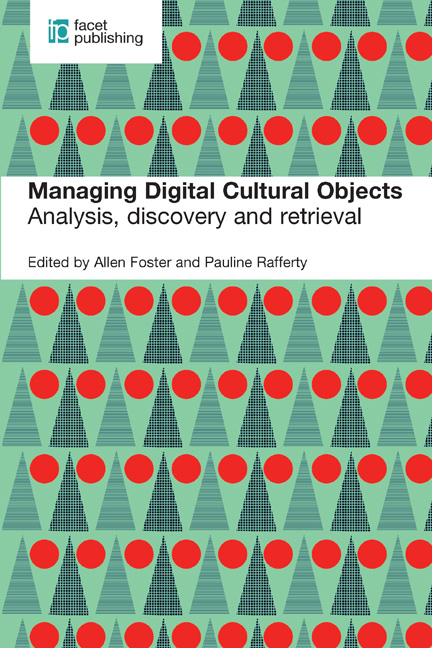Book contents
- Frontmatter
- Contents
- List of figures and tables
- Contributors
- Introduction
- PART 1 ANALYSIS AND RETRIEVAL OF DIGITAL CULTURAL OBJECTS
- 1 Managing, searching and finding digital cultural objects: putting it in context
- 2 Data modelling for analysis, discovery and retrieval
- 3 The digital traces of user-generated content: how social media data may become the historical sources of the future
- PART 2 DIGITIZATION PROJECTS IN LIBRARIES, ARCHIVES AND MUSEUMS: CASE STUDIES
- PART 3 SOCIAL NETWORKING AND DIGITAL CULTURAL OBJECTS
- Index
2 - Data modelling for analysis, discovery and retrieval
from PART 1 - ANALYSIS AND RETRIEVAL OF DIGITAL CULTURAL OBJECTS
Published online by Cambridge University Press: 09 June 2018
- Frontmatter
- Contents
- List of figures and tables
- Contributors
- Introduction
- PART 1 ANALYSIS AND RETRIEVAL OF DIGITAL CULTURAL OBJECTS
- 1 Managing, searching and finding digital cultural objects: putting it in context
- 2 Data modelling for analysis, discovery and retrieval
- 3 The digital traces of user-generated content: how social media data may become the historical sources of the future
- PART 2 DIGITIZATION PROJECTS IN LIBRARIES, ARCHIVES AND MUSEUMS: CASE STUDIES
- PART 3 SOCIAL NETWORKING AND DIGITAL CULTURAL OBJECTS
- Index
Summary
Introduction
Effective analysis, discovery and retrieval of digital cultural objects are reliant on the underlying data model adopted by an implementation. The manner in which the digital objects have been created will determine whether they can be interrogated for complex analysis. The type and scope of the metadata captured will determine the tools that can be provided for both browsing and searching, and the resulting discovery. The structure and content standards adopted for metadata creation and the formats used for digital object creation will determine whether they can be readily shared across technical implementations. Establishing the aims of the creation and delivery of a collection of digital cultural objects, and modelling the data and metadata requirements to fulfil the established aims, underpin the operational management of digital cultural objects in the custodial environment.
Defining requirements
Data modelling should not actually focus on the data to be delivered in the first instance. Rather it starts with two fundamental questions which will drive the creation of cultural digital objects and the technical specification for delivering them:
What audience is the material for?
How will the identified audience use the material?
It is only after a requirements-gathering exercise to answer these questions that an initiative should start to think about the types of digital object that will be created and supported, the structure and organization of these objects and the functionality and services that will be provided to enable analysis, discovery and retrieval (Shen et al., 2005).
Requirements gathering can be a complex process that involves looking closely at the needs of the proposed users and the wider social, personnel and technical issues. The design of a requirements-gathering exercise can be informed through the use of conceptual models which describe the wider functions of a digital library or digital repository and consider the actors as well as the data.
The OAIS Reference Model
The OAIS (Open Archival Information System) Reference Model (ISO 14721) (Consultative Committee for Space Data System Practices, 2012) is widely used as a framework for modelling a digital collection's technical and organizational requirements and conformance with the standard regarded as best practice, especially if digital objects are to be managed over the long term.
- Type
- Chapter
- Information
- Managing Digital Cultural ObjectsAnalysis, discovery and retrieval, pp. 25 - 60Publisher: FacetPrint publication year: 2016



